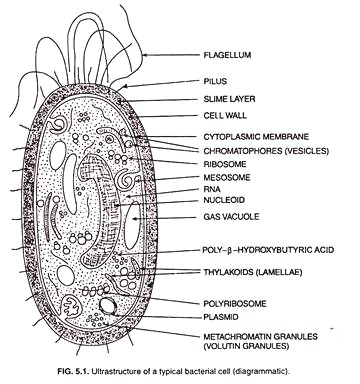In this article we will discuss about the ultrastructure of cell wall in plants. This will also help you to draw the structure and diagram of cell wall.
The cell wall is a biphasic structure consisting of cellulose microfibril embedded in gel-like non-cellulosic matrix. The microfibrillar phase consists of cellulose (β1, 4-glucan) only and the ultrastructure of cell wall is based on it. The microfibrillar phase is readily visible in Electron microscope and is crystalline, i.e. its molecules are arranged in a definite way. Moreover, it is homogeneous in chemical composition.
The microfibrillar phase is composed of microfibrils which are long, thin structure with oval or circular in cross section and have uniform width of about 10nm (1 nm = 10-9m) in higher plants.
The cambium cells have narrow width (± 3 nm). The microfibrils are made up of cellulose molecules, which are precisely defined polymer composed of purely glucose molecules linked to each other by β1, 4 bond and are unbranched 1, 4-glucan. The glucose residues C6H10O5 are linked together with oxygen atoms (Fig. 3.4).
There are at least 8000 to 15,000 glucose monomers per cellulose molecule and are 0.25 to 0.5 µm long. The molecules are flat and ribbon like, and lie parallel to each other. Hydrogen bonding occurs between the molecules, thus crystallizing and producing aggregates. These aggregates are called microfibril.
Each microfibril contains 40 to 70 chains, which lie side by side, and these can be seen in Electron micrographs. Electron microscopic study reveals that about 40 cellulose molecules are grouped together to an elementary fibril of about 3.5 nm in diameter. Later the idea of elementary fibril is considered as misconception.
The cellulose molecules form chains, which are at some regions of microfibrils, are arranged in parallel into 3-dimensional crystalline lattices termed micelles. The lattices are connected with each other by intra and inter molecular hydrogen bonds. The spaces between the microfibrils are filled up with lignin, cutin, pectic substances, hemicellulose, water etc. Thus, the microfibril gains considerable strength.
In primary cell wall, the orientation of microfibril is transverse to the long axis, and during growth the arrangement may be longitudinal. The orientation in secondary wall may differ from primary wall. Tracheids and fibres show three layers in their secondary wall the outer layer (S1), the central layer (S2) and the inner layer (S3), among which the central (S2) is the thickest.
The S1 and S3 layers lie adjacent to primary wall and cell lumen respectively. These layers S1, S2 and S3 may be distinguished by their respective orientation of cellulose microfibrils. In S1 and S3, the microfibrils are in the form of a lax helix and in S2, it is a steep one (Fig 3.5).
The microfibrils are aggregated to form macrofibrils, which are composed of about 5,00,000 cellulose molecules in transection. The macrofibrils are about 0.4 µm wide and can be visible under light microscope. Several macrofibrils are combined together to form the cell wall. Preston suggested that microtubule directs the arrangement of microfibrils.
It is certain from chemical analysis and X-ray diffraction studies that the major bulk of microfibril is composed of crystalline β1, 4-Glucan. Later evidences suggest that α-cellulose fraction of cell wall contains mannose and xylose in addition to glucose. The microfibrils may consist of a central core of crystalline cellulose micelle.
Major components of the cell walls are cellulose, pectins, hemicellulose, proteins and phenolics whose presence has extremely complicated the overall structure of cell wall. So, a number of models were proposed to explain the arrangement of the (cell wall) components in the wall.
Mention may be made of the model of (Fig. 3.6) Lamport and Epstein, 1983, which explains the interrelationships between matrix molecules and cellulose microfibrils. According to this model the protein molecules lie perpendicular to cell surface through which the microfibril passes. There are covalent links between protein and cellulose microfibrils, and between the proteins.


